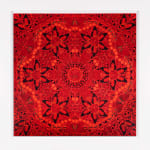




Damien Hirst
'Wu Zetian' with Diamond Dust, 2022
Giclée print on aluminum composite, screen print with glitter
47.5 x 47.5 x 2 in
120.7 x 120.7 x 5.1 cm
120.7 x 120.7 x 5.1 cm
Edition of 3315
Signed by the Artist on verso.
Copyright The Artist
Currency:
Further images
Damien Hirst’s ‘Wu Zetian’ is laminated giclée print on aluminum composite panel with glittering diamond dust, and is one in a series of five mesmerizing prints in ‘The Empresses’ series....
Damien Hirst’s ‘Wu Zetian’ is laminated giclée print on aluminum composite panel with glittering diamond dust, and is one in a series of five mesmerizing prints in ‘The Empresses’ series. ‘Wu Zetian’ is titled after the successful Chinese empress. In 655 CE Wu Zetian (624-705 CE) married Emperor Gaozong and gradually began to involve herself in political affairs, much to the dismay of many statesmen. Using her extraordinary intelligence, Wu Zetian created stability in the empire and consolidated the Tang Dynasty at a time when it appeared to be crumbling. The butterflies in this shimmering print transform into six blossoming groups, referencing the significance of the lucky number six in Chinese idioms. The number also relates to the hexagon, which in China evokes the six directions (North, South, East, West, Heaven and Earth) and therefore represents completeness, harmony and balance. ’Wu Zetian’ comes in a custom-made museum caliber frame and is signed by the Artist on verso.
Damien Hirst is a British contemporary master artist and entrepreneur recognized for his iconic artworks that have defined the contemporary art world for over a decade. His varied practice, which includes installation, sculpture, painting, and drawing, explores the complex relationships between life, death, art, religion, and science. Hirst was born in Bristol in 1965 and grew up in Leeds, England. In 1984, he moved to London, where he worked in construction before enrolling at Goldsmiths University of London, in 1986 to study fine art. While at Goldsmiths, Hirst organized the independent student exhibition 'Freeze', which has become legendary as the originating moment of the Young British Artists (YBAs). 'Freeze', which exhibited Hirst’s first spot paintings, launched Hirst and 15 of his fellow students to fame, making their place in art history. In 1991, Charles Saatchi, offering to fund Hirst’s artwork, mounted the first Young British Artists (YBA) exhibition at the Saatchi Gallery in London. Among the works exhibited was 'The Physical Impossibility of Death in the Mind of Someone Living' (1991), a shark submerged in a formaldehyde vitrine, which became an overnight global sensation. As a result of the show, Hirst was nominated for that year's Turner Prize. Hirst later won the Turner Prize in 1995 for the work, 'Mother and Child Divided'. Known best for his use of symbols, the 'Universal Triggers' utilized throughout his career have instant relatability in connection with universal questions about life, death, love and everything in between. Hirst is well recognized for his spot paintings, medicine cabinet motifs, brightly colored spin paintings, kaleidoscopic butterflies, large-scale sculptural installations and diamond-encrusted skulls. Since 1987, there have been over 80 solo Damien Hirst exhibitions that have taken place worldwide and his work has been included in over 260 group shows. Damien Hirst's impact on the art world has had a similar effect to that of the contemporary masters before him, with similarities to be drawn from the monumental pop art work of Andy Warhol, the street-art sensation installation master Keith Haring, the expressive and vibrant paintings of Jean-Michel Basquiat, and innovative approach of Marcel Duchamp. Damien Hirst continues to work and create art in the present day, with his recent focus primarily on paintings.
Damien Hirst is a British contemporary master artist and entrepreneur recognized for his iconic artworks that have defined the contemporary art world for over a decade. His varied practice, which includes installation, sculpture, painting, and drawing, explores the complex relationships between life, death, art, religion, and science. Hirst was born in Bristol in 1965 and grew up in Leeds, England. In 1984, he moved to London, where he worked in construction before enrolling at Goldsmiths University of London, in 1986 to study fine art. While at Goldsmiths, Hirst organized the independent student exhibition 'Freeze', which has become legendary as the originating moment of the Young British Artists (YBAs). 'Freeze', which exhibited Hirst’s first spot paintings, launched Hirst and 15 of his fellow students to fame, making their place in art history. In 1991, Charles Saatchi, offering to fund Hirst’s artwork, mounted the first Young British Artists (YBA) exhibition at the Saatchi Gallery in London. Among the works exhibited was 'The Physical Impossibility of Death in the Mind of Someone Living' (1991), a shark submerged in a formaldehyde vitrine, which became an overnight global sensation. As a result of the show, Hirst was nominated for that year's Turner Prize. Hirst later won the Turner Prize in 1995 for the work, 'Mother and Child Divided'. Known best for his use of symbols, the 'Universal Triggers' utilized throughout his career have instant relatability in connection with universal questions about life, death, love and everything in between. Hirst is well recognized for his spot paintings, medicine cabinet motifs, brightly colored spin paintings, kaleidoscopic butterflies, large-scale sculptural installations and diamond-encrusted skulls. Since 1987, there have been over 80 solo Damien Hirst exhibitions that have taken place worldwide and his work has been included in over 260 group shows. Damien Hirst's impact on the art world has had a similar effect to that of the contemporary masters before him, with similarities to be drawn from the monumental pop art work of Andy Warhol, the street-art sensation installation master Keith Haring, the expressive and vibrant paintings of Jean-Michel Basquiat, and innovative approach of Marcel Duchamp. Damien Hirst continues to work and create art in the present day, with his recent focus primarily on paintings.




